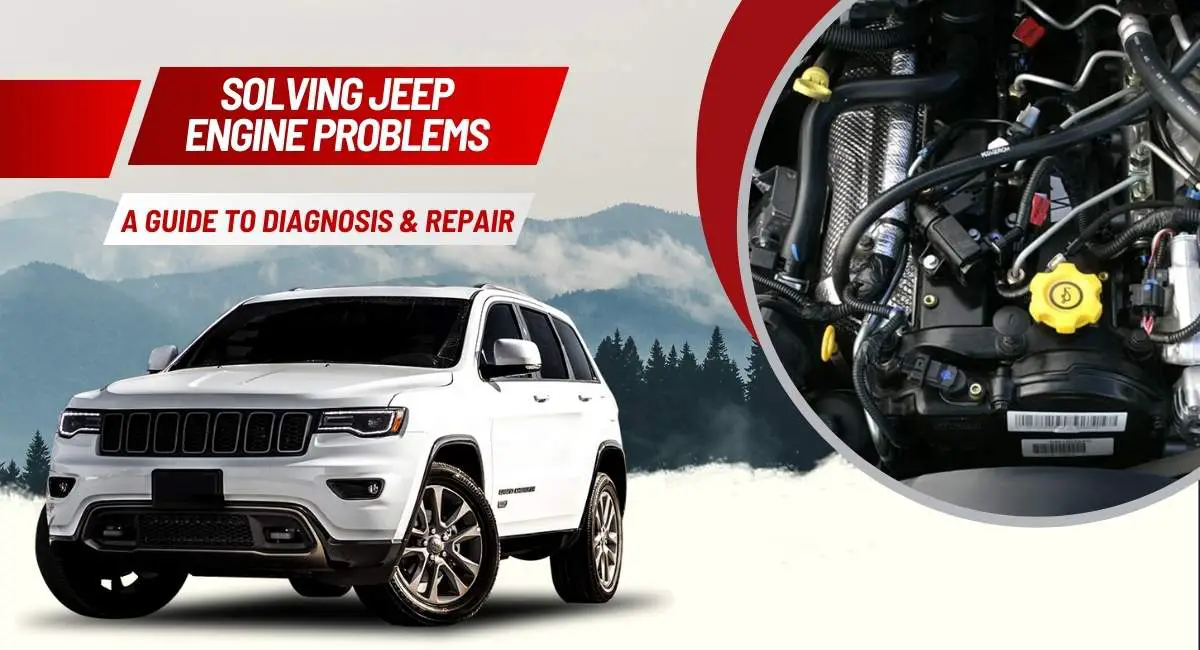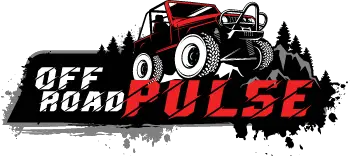The Jeep is arguably the champion of off-roading and is renowned for its ruggedness and adventurous spirit. This SUV has been around for decades, plus it has created a loyal fan base over time. However, while Jeep engines are built to withstand the demands of adventure, Jeep owners often find themselves grappling with the complexities of engine maintenance.
Key Takeaways
- If you’re not an automotive expert, it can be frustrating when your Jeep develops engine problems for no obvious reason.
- Well, there are many reasons why your engine may suddenly fail to start or misfire, but there’s no need to feel overwhelmed.
- In this guide, we’ll discuss solutions to common Jeep engine problems and how you can keep your Jeep running smoothly for years to come.
Common Jeep Engine Problems
Overheating
Overheating is a common issue in Jeep engines, particularly during off-road excursions or when towing heavy loads. It is common for engines to overheat occasionally during hot summer months, but it can also occur at any other season of the year.
Symptoms of Overheating
- A sudden rise in the engine temperature gauge beyond the normal range.
- Steam or smoke coming from under the hood.
- Some Jeep models may have warning lights that illuminate when the engine temperature exceeds safe limits.
- As engine temperature increases, performance may decrease due to fuel combustion inefficiencies or engine protection mechanisms.

Causes of Engine Overheating
Coolant Leaks
If there’s a leak in your Jeep’s coolant system, it means that the hoses, radiator, or water pump might be damaged or worn out. This leak lowers the amount of coolant needed to keep the engine cool, leading to overheating.
Thermostat Failure
If the thermostat fails or gets stuck closed, it prevents the proper flow of coolant through the engine. This means coolant cannot circulate as it should, leading to a lack of proper cooling. As a result, the engine’s temperature can rise quickly beyond safe levels.
Cooling Fan Issues
Similarly, if the cooling fan isn’t working properly, it means that there’s not enough airflow passing through the radiator to cool down the engine. This becomes especially problematic when driving at low speeds or idling for an extended period.
Radiator Problems
Blockages in the radiator, whether from debris or corrosion, can restrict airflow and reduce its ability to cool the coolant passing through it. When this happens, the engine heats up more quickly, leading to overheating.
Cooling System Contamination
If there’s dirt or air pockets in the Jeep’s cooling system, it disrupts the flow of coolant. Without proper circulation, the coolant can’t transfer heat away from the engine, resulting in overheating.
Solutions
First things first, you’ll need to pop the hood and check the coolant level in the radiator and overflow tank. If it’s low, top it up with the recommended coolant mixture and inspect for any visible leaks. If you suspect the thermostat is to blame for the overheating, consider replacing it.
Next, take a close look at the components of the cooling system – hoses, radiator, water pump, and cooling fan. If any of these parts are damaged or malfunctioning, replace them as needed. Equally important, consider flushing your cooling system to remove any contaminants that could be hindering coolant flow.
Rough Idling
Rough idle occurs when the engine doesn’t run smoothly while it’s idling. This issue is characterized by the engine struggling to maintain a consistent and steady idle speed, resulting in noticeable vibrations and a generally unstable feeling.
Symptoms of Rough Idling
- The engine might shake or vibrate more than usual, making the whole vehicle feel rough and unsettled.
- You might also observe an irregular or fluctuating idle speed on the tachometer.
- Sometimes, you might even hear unusual sounds coming from the engine bay, like sputtering or misfiring.
Causes of Rough Idling
Dirty or Faulty Spark Plugs
Spark plugs are bound to accumulate carbon deposits, causing them to misfire or not fire at all. Additionally, if the spark plugs are worn out or damaged, they won’t ignite the air-fuel mixture properly, leading to rough idle.
Air or Vacuum Leaks
Any unintended openings or cracks in the intake manifold, vacuum hoses, or other air-related components can allow unmetered air to enter the engine. This disrupts the air-fuel mixture, resulting in irregular combustion and rough idle.
Clogged Fuel Filter
If the fuel filter is clogged, it restricts the flow of fuel to the engine, leading to fuel starvation and rough idling. This prevents the spray of fuel evenly or at the right time, thereby affecting ride quality.
Idle Air Control Valve (IACV) Fault
The IACV regulates the amount of air entering the engine during idle. If it becomes dirty, stuck, or malfunctions electronically, it can’t adjust airflow properly, leading to erratic idle speed and roughness.
Throttle Body Issues
A dirty or malfunctioning throttle body can disrupt the airflow into the engine, thereby affecting the air-fuel mixture and resulting in rough idle. Similarly, a faulty throttle position sensor can make the throttle body fail to respond to driver inputs, leading to an unstable engine idle.
Solutions
Start by checking the condition of the spark plugs. If they’re dirty, worn out, or faulty, replace them with new ones to ensure proper ignition and combustion. In addition, carefully inspect the intake manifold, vacuum hoses, and other air-related components for any signs of leaks.
Next, examine the fuel filter, fuel injectors, and fuel pressure regulator to ensure they’re functioning correctly. Finally, clean the throttle body and IACV to remove any carbon buildup or debris that could be affecting airflow into the engine.
Oil Leaks
Oil leaks are never a good sign, and they are another prevalent issue in Jeep engines. An oil leak occurs when engine oil escapes from its intended pathways and seeps out onto the engine or the ground beneath the vehicle.
Symptoms of Oil Leaks
- Detecting an oil leak isn’t too tricky. The most obvious sign is dark, greasy stains on the ground where you park.
- You might also smell burning oil when driving.
- If the leak is bad enough, you might see smoke coming from under the hood, which is definitely cause for concern.
Causes of Oil Leaks
Worn Gaskets or Seals
The gaskets and seals that keep the engine oil contained can deteriorate due to heat, pressure, and general wear and tear. This can lead to leaks around components such as the oil pan, valve cover, oil filter housing, or timing cover.
Loose or Damaged Oil Drain Plug
If the oil drain plug isn’t tightened properly during an oil change, it can loosen and allow oil to leak from the oil pan. Additionally, if the drain plug’s threads are damaged, it may not seal correctly, causing leaks.
Cracked or Damaged Oil Pan
The oil pan is located underneath the engine and holds the engine oil. This pan can be damaged by impacts from road debris or by improper installation. Even a small crack in the oil pan can lead to significant oil leaks.
Failed Valve Cover Gasket
The valve cover gasket seals the gap between the cover and the engine block. Over time, this gasket can become brittle and develop cracks, allowing oil to leak out. Additionally, a faulty PCV valve can cause excess pressure in the crankcase, leading to oil leaks from the cover gasket.
Solutions
First, you’ll need to pinpoint exactly where the leak is coming from. You may want to get underneath the vehicle and inspect the engine and its components carefully. If the leak is due to worn components, you’ll need to replace them. This might involve disassembling the engine to access the components.
Stalling
Stalling can be a relatively common issue, particularly in older Jeeps or those with higher mileage. Stalling can happen while driving, idling, or when trying to start the vehicle. It’s an abrupt event that can leave you stuck, especially if it happens in traffic or on a busy road.
Symptoms of Stalling
- The engine might sputter or hesitate before shutting off completely.
- You might also see the check engine light come on or experience a sudden loss of power.
- Sometimes, the steering and brakes can become harder to use when the engine stalls, making it more difficult to control the vehicle
Causes of Stalling
Fuel System Issues
If there’s a problem with the fuel system, such as a clogged fuel filter, failing fuel pump, or dirty fuel injectors, the engine might not get enough fuel to run properly, leading to stalling.
Ignition System Problems
Faulty spark plugs, ignition coils, or a malfunctioning ignition control module can cause misfires or prevent the engine from running smoothly, resulting in stalling.
Vacuum Leaks
Leaks in the vacuum system can disrupt the air-fuel mixture and cause the engine to stall. Common sources of vacuum leaks include cracked or disconnected hoses and a failing intake manifold gasket.
Electrical Problems
Issues with the vehicle’s electrical system, such as a failing alternator or battery, can cause the engine to lose power and stall. Similarly, faulty wiring or connections can also disrupt the engine’s operation.
Solutions
You can start by checking the fuel filter for clogs and replacing it if necessary. Also, inspect the spark plug and fuel pump to ensure proper ignition and fuel delivery, respectively. Check the battery and alternator to ensure they’re providing adequate power to the engine. You may also want to inspect the wiring and connections for any signs of damage or corrosion and repair them if needed.
Misfires
Engine misfire occurs when one or more of the engine’s cylinders fail to ignite the air-fuel mixture at the correct time. This means that the engine is missing one or more power strokes, causing it to stumble or run unevenly. Misfires can be intermittent, happening occasionally, or they can be constant, thereby affecting engine performance all the time.
Symptoms of Misfires
- The engine may stumble or hesitate during acceleration, making the vehicle feel sluggish and unresponsive.
- When idling, the engine may run unevenly and feel rough, almost as if it is shuddering or vibrating irregularly.
- The Jeep might struggle to pick up speed or feel underpowered.
- The check engine light frequently illuminates when a misfire occurs.
- Unusual sounds coming from the engine or exhaust, such as popping, coughing, or backfiring.
- Increased emissions, resulting in higher levels of pollutants being released from the exhaust.
Causes of Misfires
Faulty Spark Plugs
As we mentioned, spark plugs wear out due to electrode erosion and deposit buildup. If the spark plug gap widens or becomes fouled, it can lead to weak or inconsistent sparks, resulting in misfires, especially under load or at high speeds.
Faulty Ignition Coils
Ignition coils are responsible for converting the low-voltage battery power into the high-voltage sparks needed to ignite the air-fuel mixture in the cylinders. If a coil fails or deteriorates, it can cause intermittent or no spark, leading to misfires in one or more cylinders.
Fuel Delivery Issues
Problems in the fuel delivery system, such as clogged fuel injectors, a malfunctioning fuel pump, or a faulty fuel pressure regulator, can disrupt the air-fuel mixture ratio. This imbalance can cause lean or rich conditions, resulting in misfires during acceleration or idle.
Compression Issues
Low compression in one or more cylinders can occur due to worn piston rings, leaking valves, or a blown head gasket. Reduced compression leads to incomplete combustion and misfires, particularly during acceleration or when the engine is cold.
Solutions
Start by scanning for diagnostic trouble codes using an OBD-II scanner to pinpoint the cylinders experiencing misfires. Once identified, proceed with visual inspections, checking components like spark plugs, ignition coils, and vacuum hoses for signs of wear or damage.
Additionally, conduct tests such as compression tests to assess engine health and verify proper timing alignment. Address fuel delivery issues by cleaning or replacing clogged fuel injectors and ensuring adequate fuel pressure. Verify sensor functionality and replace any malfunctioning sensors affecting fuel and ignition timing.
Parting Shot!
Maintaining your Jeep’s engine is essential for ensuring its longevity, reliability, and optimal performance. If you notice any of these prevalent engine issues, it’s crucial not to overlook them. However, if you encounter complex engine problems that you’re not equipped to diagnose or repair, it’s best to seek assistance.




